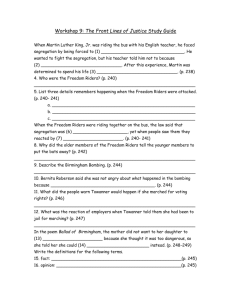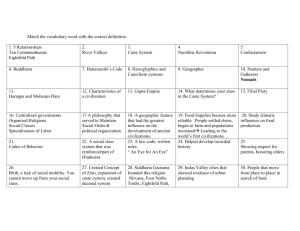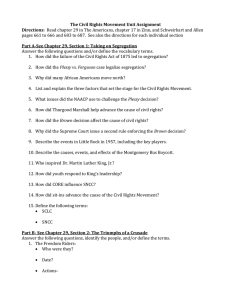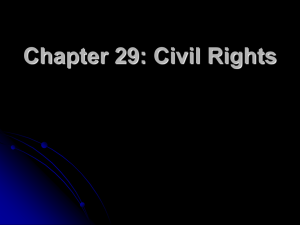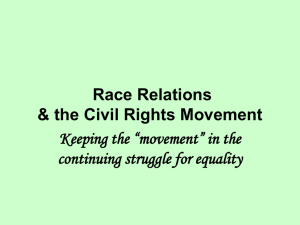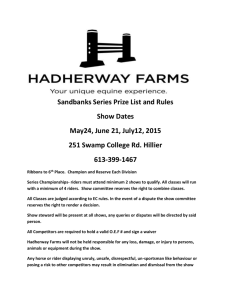The article "1961: The Freedom Riders" was written by Merrill
advertisement
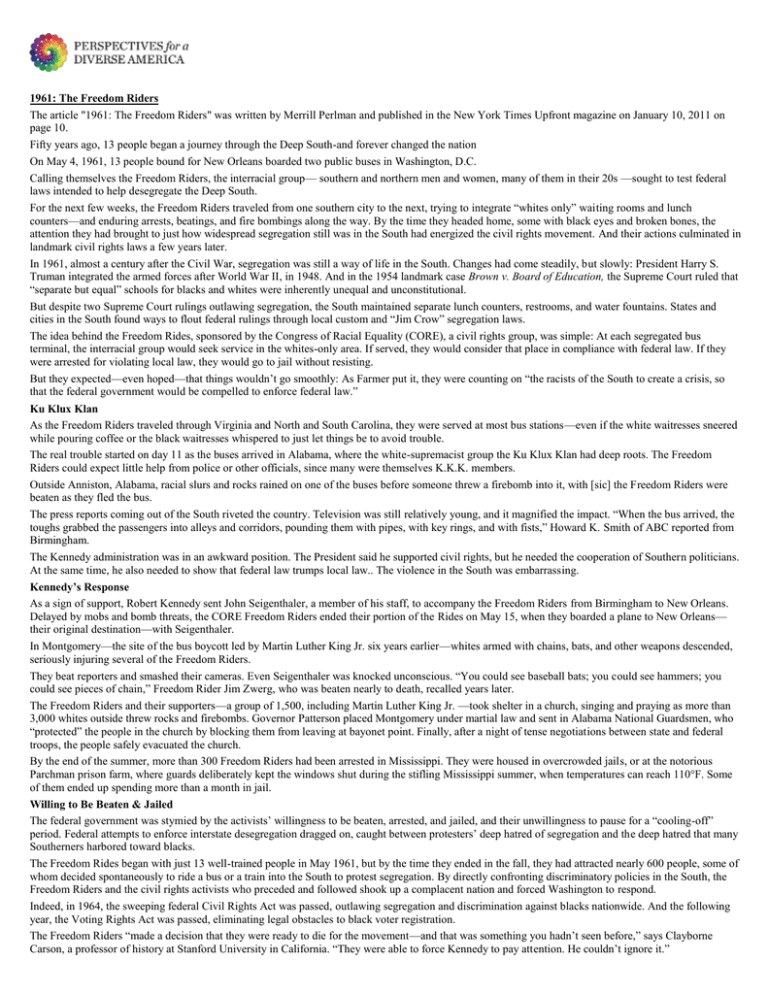
1961: The Freedom Riders The article "1961: The Freedom Riders" was written by Merrill Perlman and published in the New York Times Upfront magazine on January 10, 2011 on page 10. Fifty years ago, 13 people began a journey through the Deep South-and forever changed the nation On May 4, 1961, 13 people bound for New Orleans boarded two public buses in Washington, D.C. Calling themselves the Freedom Riders, the interracial group— southern and northern men and women, many of them in their 20s —sought to test federal laws intended to help desegregate the Deep South. For the next few weeks, the Freedom Riders traveled from one southern city to the next, trying to integrate “whites only” waiting rooms and lunch counters—and enduring arrests, beatings, and fire bombings along the way. By the time they headed home, some with black eyes and broken bones, the attention they had brought to just how widespread segregation still was in the South had energized the civil rights movement. And their actions culminated in landmark civil rights laws a few years later. In 1961, almost a century after the Civil War, segregation was still a way of life in the South. Changes had come steadily, but slowly: President Harry S. Truman integrated the armed forces after World War II, in 1948. And in the 1954 landmark case Brown v. Board of Education, the Supreme Court ruled that “separate but equal” schools for blacks and whites were inherently unequal and unconstitutional. But despite two Supreme Court rulings outlawing segregation, the South maintained separate lunch counters, restrooms, and water fountains. States and cities in the South found ways to flout federal rulings through local custom and “Jim Crow” segregation laws. The idea behind the Freedom Rides, sponsored by the Congress of Racial Equality (CORE), a civil rights group, was simple: At each segregated bus terminal, the interracial group would seek service in the whites-only area. If served, they would consider that place in compliance with federal law. If they were arrested for violating local law, they would go to jail without resisting. But they expected—even hoped—that things wouldn’t go smoothly: As Farmer put it, they were counting on “the racists of the South to create a crisis, so that the federal government would be compelled to enforce federal law.” Ku Klux Klan As the Freedom Riders traveled through Virginia and North and South Carolina, they were served at most bus stations—even if the white waitresses sneered while pouring coffee or the black waitresses whispered to just let things be to avoid trouble. The real trouble started on day 11 as the buses arrived in Alabama, where the white-supremacist group the Ku Klux Klan had deep roots. The Freedom Riders could expect little help from police or other officials, since many were themselves K.K.K. members. Outside Anniston, Alabama, racial slurs and rocks rained on one of the buses before someone threw a firebomb into it, with [sic] the Freedom Riders were beaten as they fled the bus. The press reports coming out of the South riveted the country. Television was still relatively young, and it magnified the impact. “When the bus arrived, the toughs grabbed the passengers into alleys and corridors, pounding them with pipes, with key rings, and with fists,” Howard K. Smith of ABC reported from Birmingham. The Kennedy administration was in an awkward position. The President said he supported civil rights, but he needed the cooperation of Southern politicians. At the same time, he also needed to show that federal law trumps local law.. The violence in the South was embarrassing. Kennedy’s Response As a sign of support, Robert Kennedy sent John Seigenthaler, a member of his staff, to accompany the Freedom Riders from Birmingham to New Orleans. Delayed by mobs and bomb threats, the CORE Freedom Riders ended their portion of the Rides on May 15, when they boarded a plane to New Orleans— their original destination—with Seigenthaler. In Montgomery—the site of the bus boycott led by Martin Luther King Jr. six years earlier—whites armed with chains, bats, and other weapons descended, seriously injuring several of the Freedom Riders. They beat reporters and smashed their cameras. Even Seigenthaler was knocked unconscious. “You could see baseball bats; you could see hammers; you could see pieces of chain,” Freedom Rider Jim Zwerg, who was beaten nearly to death, recalled years later. The Freedom Riders and their supporters—a group of 1,500, including Martin Luther King Jr. —took shelter in a church, singing and praying as more than 3,000 whites outside threw rocks and firebombs. Governor Patterson placed Montgomery under martial law and sent in Alabama National Guardsmen, who “protected” the people in the church by blocking them from leaving at bayonet point. Finally, after a night of tense negotiations between state and federal troops, the people safely evacuated the church. By the end of the summer, more than 300 Freedom Riders had been arrested in Mississippi. They were housed in overcrowded jails, or at the notorious Parchman prison farm, where guards deliberately kept the windows shut during the stifling Mississippi summer, when temperatures can reach 110°F. Some of them ended up spending more than a month in jail. Willing to Be Beaten & Jailed The federal government was stymied by the activists’ willingness to be beaten, arrested, and jailed, and their unwillingness to pause for a “cooling-off” period. Federal attempts to enforce interstate desegregation dragged on, caught between protesters’ deep hatred of segregation and the deep hatred that many Southerners harbored toward blacks. The Freedom Rides began with just 13 well-trained people in May 1961, but by the time they ended in the fall, they had attracted nearly 600 people, some of whom decided spontaneously to ride a bus or a train into the South to protest segregation. By directly confronting discriminatory policies in the South, the Freedom Riders and the civil rights activists who preceded and followed shook up a complacent nation and forced Washington to respond. Indeed, in 1964, the sweeping federal Civil Rights Act was passed, outlawing segregation and discrimination against blacks nationwide. And the following year, the Voting Rights Act was passed, eliminating legal obstacles to black voter registration. The Freedom Riders “made a decision that they were ready to die for the movement—and that was something you hadn’t seen before,” says Clayborne Carson, a professor of history at Stanford University in California. “They were able to force Kennedy to pay attention. He couldn’t ignore it.” Multiple Choice Questions 1. How would you cite the following quote from the excerpt in a research paper? “And in the 1954 landmark case Brown v. Board of Education, the Supreme Court ruled that “separate but equal” schools for blacks and whites were inherently unequal and unconstitutional.” A. B. C. D. 2. (Perlman, par. 5) (“1961: The Freedom Riders, par. 5) (Perlman, pg. 10) (“1961: The Freedom Riders, pg. 10) According to the article, what was a direct outcome of the efforts of the Freedom Riders? A. B. C. D. Led directly to schools and buses being desegregated Led to politicians to take notice of the problem and pass legislation to combat segregation Forced the Ku Klux Klan to be disbanded Led to the death of Martin Luther King, Jr. 3. Which quotation below best represents what the Freedom Riders hoped to accomplish? A. “But despite two Supreme Court rulings outlawing segregation, the South maintained separate lunch counters, restrooms, and water fountains. States” B. “As Farmer put it, they were counting on “the racists of the South to create a crisis, so that the federal government would be compelled to enforce federal law.” C. “The Freedom Rides began with just 13 well-trained people in May 1961, but by the time they ended in the fall, they had attracted nearly 600 people, some of whom decided spontaneously to ride a bus or a train into the South to protest segregation” D. “The federal government was stymied by the activists’ willingness to be beaten, arrested, and jailed, and their unwillingness to pause for a “cooling-off” period.” 4. Which quote below is best illustrative of foreshadowing of the violence to come for the Freedom Riders? A. “The federal government was stymied by the activists’ willingness to be beaten, arrested, and jailed, and their unwillingness to pause for a “cooling-off” period.” B. “Calling themselves the Freedom Riders, the interracial group— southern and northern men and women, many of them in their 20s —sought to test federal laws intended to help desegregate the Deep South.” C. “The real trouble started on day 11 as the buses arrived in Alabama, where the white-supremacist group the Ku Klux Klan had deep roots.” D. “Indeed, in 1964, the sweeping federal Civil Rights Act was passed, outlawing segregation and discrimination against blacks nationwide.” 5. Read the excerpt below: “Governor Patterson placed Montgomery under martial law and sent in Alabama National Guardsmen, who “protected” the people in the church by blocking them from leaving at bayonet point.” What is the author’s purpose of placing the word “protected” in quotation marks? A. B. C. The author is using sarcasm to show the Guardsmen did not mean to protect the protestors The author is using protected as a direct quotation The author is emphasizing the importance of the Guardsmen protecting the protesters 6. What is the author’s purpose in writing this article? A. To inform the audience B. To entertain the audience C. To persuade the audience 7. Which excerpt below is best illustrative of the main idea of this article? A. “In 1961, almost a century after the Civil War, segregation was still a way of life in the South” B. “As the Freedom Riders traveled through Virginia and North and South Carolina, they were served at most bus stations—“ C. “For the next few weeks, the Freedom Riders traveled from one southern city to the next, trying to integrate “whites only” waiting rooms and lunch counters—and enduring arrests, beatings, and fire bombings along the way.” D. “And their actions culminated in landmark civil rights laws a few years later.” 8. Which synonym below best represent how the Freedom Riders felt the federal government had handled desegregation prior to their activism? A. Determined B. Hopeful C. Worthy D. Ineffectual 9. Which synonyms below best represent how the Freedom Riders felt about local Southern governments during the Jim Crow Era? A. Discriminatory B. Ineffectual C. Egalitarian

